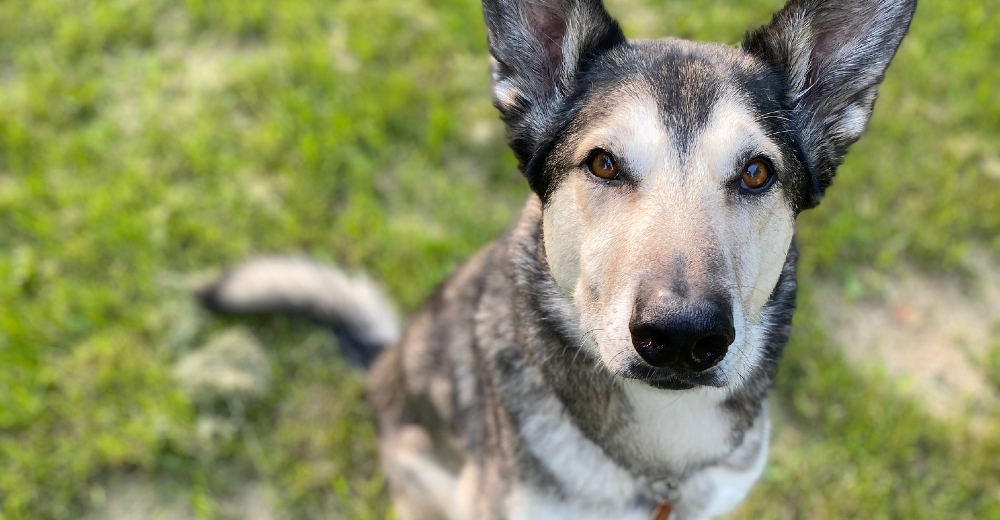By Bevin Bradley
For the last 20 years, I’ve been running with a dog at my side.
My first running companion was a pit bull/shepherd, then a husky/malamute, and now I run with my shepherd/husky cross named Aspen. They have all been rescues from either the SPCA or New Hope Dog Rescue.
For me, running with a dog brings me a happiness and satisfaction that I can’t achieve running alone. They have helped me train for marathons, half-marathons and triathlons, usually running with me two or three times a week.
My running partners have been just as varied as my training plan in their ability to train beside me and I’ve learned a lot along the way.
Why run with a dog?
- It’s good for you! My dog is my accountability partner. He always wants to run and lets me know when we haven’t gone far enough or if we miss a run. Running with a dog gives my run a greater sense of purpose; it not just about my fitness, but about his health and enjoyment. I feel safer with him by my side, especially on quieter trails where fewer people are around. On days I am low energy, he is the one pulling me forward literally and figuratively.
- It’s good for the dog. An exercised dog is a well-behaved dog. Running with my dogs was frustrating at first, but improved with practice. I consistently run with Aspen on my left and he doesn’t trip me by switching sides. I like a short leash, about a metre long, so he stays at my hip and I can control his movements. The exercise he gets running keeps him from out of trouble; he is less likely to chew shoes, jump up or bark if he has had a run. Running on pavement keeps his nails short and saves me the trouble of clipping them as often.
- It creates a strong bond. Running together builds trust because it builds a pack mentality through the act of travelling together. The experiences I have while running teach my dog he can count on me. For example, running up the metal stairs in the east side of the train bridge was difficult for my dog at first, but because he learned to trust me he can do it without fear.
When to leave your dog at home
- When they are under a year old. I have learned how important it is to wait until my dog is fully mature as running them too hard too early will burn out their joints and you won’t see the effects of that until they are older. Young dogs need to fully develop before they can run significant distances, and waiting for them to be ready will pay off in the end and is worth it in the long run!
- In the heat. It is hard to measure when it’s too warm for your dog to run as it depends on their breed, how long you’re running, how far, and where you are going. If you are running on cement on a hot day, keep in mind it can burn their pads. If they haven’t already built up the skin on their pads from regular runs on cement, they’ll be more susceptible to burning. My husky/malamute had a thick coat and could overheat quickly so I stuck with early morning or night runs. We began each run with a swim in the river and we usually stopped halfway through for another quick dip to cool him down. Dogs can cool themselves through their feet so stepping in puddles can help if you aren’t near a river. Running along the dirt trails is always better for dogs on a hot day; the shade of the trees will help keep them cool and the dirt isn’t as hard on their pads. But if it’s really hot, leave them at home.
- When the length of the run exceeds their capacity. Not all dogs are marathon runners. My introduction to endurance training was through the Arthritis Societies’s Joints in Motion fundraiser where I travelled to Dublin, Ireland to run a marathon. At the time, my pitfall/shepherd-cross was my devout training partner. As I followed my training plan and worked towards my longest training run of 32 kilometres, I realized I had to make a difficult decision: to leave my dog at home. After running just 16 kilometres with him, he couldn’t walk the next day. I hadn’t realized his hips couldn’t handle long runs. It was heart-wrenching because at the time I was living with a roommate and I worked all day. I was the sole provider for my dog – he relied on me for entertainment, exercise, and companionship. After being away from him all day, I had to close the door on him once again as I headed out for a run even though he wanted to go. Knowing and minding the limits of your dog is a test of will-power. This past winter Aspen tore his CCL (a dog’s version of a ACL). It has been tough to keep up my running schedule while he rests, but I know resting him now will result in a better recovery for him.
Tips for running in winter
- Avoid salt! Salt on sidewalks and roads stings your dogs paws. If you can choose a route that has less salt (residential areas usually have less) or cross the street, you dog will thank you.
- Watch for signs your dog is cold. If you dog is lifting his paws it doesn’t necessarily mean they are cold. Check their paws and if the snow is clumped in the fur between the pads it might help to keep the fur trim. If their ears are back and they seem to be lagging behind, it could be a sign they are cold and want to go home. If you have a breed with a warm coat, running in cold weather shouldn’t be a problem.
Nothing beats running with your dog and the list of benefits are endless — but always keep in mind we’re their primary caregivers and have to choose what’s best for them.
Cause for Paws in support of the Saskatoon SPCA takes place on Sept. 7. Aspen and I hope to see you there!
Bevin Bradley is an artist, curator, runner and supporter of the SPCA.









